
A hymn is a type of song, and partially synonymous with devotional song, specifically written for the purpose of adoration or prayer, and typically addressed to a deity or deities, or to a prominent figure or personification. The word hymn derives from Greek ὕμνος (hymnos), which means "a song of praise". A writer of hymns is known as a hymnist. The singing or composition of hymns is called hymnody. Collections of hymns are known as hymnals or hymn books. Hymns may or may not include instrumental accompaniment. Polyhymnia is the Greco/Roman goddess of hymns.

Charles Wesley was an English Anglican cleric and a principal leader of the Methodist movement. Wesley was a prolific hymnwriter who wrote over 6,500 hymns during his lifetime. His works include "And Can It Be", "O for a Thousand Tongues to Sing", "Christ the Lord Is Risen Today", "Love Divine, All Loves Excelling", the carol "Hark! The Herald Angels Sing", and "Lo! He Comes With Clouds Descending".

A hymnal or hymnary is a collection of hymns, usually in the form of a book, called a hymnbook. They are used in congregational singing. A hymnal may contain only hymn texts ; written melodies are extra, and more recently harmony parts have also been provided.

"Love Divine, All Loves Excelling" is a Christian hymn by Charles Wesley on Christian perfection. Judging by general repute, it is among Wesley's finest. Judging by its distribution, it is also among his most successful.

"O for a Thousand Tongues to Sing" is a Christian hymn written by Charles Wesley. The hymn was placed first in John Wesley's A Collection of Hymns for the People Called Methodists published in 1780. It was the first hymn in every (Wesleyan) Methodist hymnal from that time until the publication of Hymns and Psalms in 1983.
Erik Reginald Routley was an English Congregational churchman, theologian and musician and prominent hymnologist.

"Christ the Lord Is Risen Today" is a Christian hymn associated with Easter. Most of the stanzas were written by Charles Wesley, and the hymn appeared under the title "Hymn for Easter Day" in Hymns and Sacred Poems by Charles and John Wesley in 1739. The hymn eventually became well known for the "Alleluia" sung as a melisma after each line, which was added by an unknown author, probably to fit the commonly used hymn tune, "Easter Hymn". It remains a traditional processional hymn on Easter Sunday.

"Rock of Ages" is a popular Christian hymn written by the Reformed Anglican minister Augustus Toplady.

Hymns Ancient and Modern is a hymnal in common use within the Church of England, a result of the efforts of the Oxford Movement. The hymnal was first published in 1861. The organization publishing it has now been formed into a charitable trust, Hymns Ancient and Modern Ltd, and As of 2022 it publishes a wide range of hymnals as well as other theological and religious books and magazines, under imprints including the acquired publishers Canterbury Press and SCM Press.
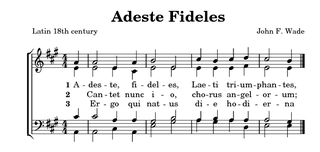
A hymn tune is the melody of a musical composition to which a hymn text is sung. Musically speaking, a hymn is generally understood to have four-part harmony, a fast harmonic rhythm, with or without refrain or chorus.
Hymnology is the scholarly study of religious song, or the hymn, in its many aspects, with particular focus on choral and congregational song. It may be more or less clearly distinguished from hymnody, the creation and practice of such song. Hymnologists, such as Erik Routley, may study the history and origins of hymns and of traditions of sung worship, the biographies of the women and men who have written hymns that have passed into choral or congregational use, the interrelationships between text and tune, the historical processes, both folk and redactional, that have changed hymn texts and hymn tunes over time, and the sociopolitical, theological and aesthetic arguments concerning various styles of sung worship.

"Immortal, Invisible, God Only Wise" is a Christian hymn with words by the Free Church of Scotland minister, Walter Chalmers Smith, usually sung to the tune, "St. Denio", originally a Welsh ballad tune, which became a hymn in Caniadau y Cyssegr edited by John Roberts (1822–1877). Of this hymn, musicologist Erik Routley has written:
"[Immortal, Invisible] should give the reader a moment's pause. Most readers will think they know this hymn, the work of another Free Kirk minister. But it never now appears as its author wrote it, and a closer look at it in its fuller form shows that it was by no means designed to be one of those general hymns of praise that the parson slams into the praise-list when he is in too much of a hurry to think of anything else but a hymn about the reading of Scripture. Just occasionally editorial tinkering changes the whole personality of a hymn; it has certainly done so here."
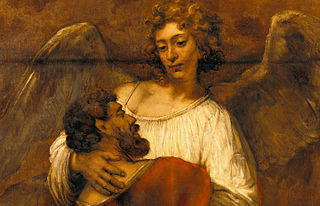
"Wrestling Jacob", also known by its incipit, "Come, O thou Traveller unknown", is a Christian hymn written by Methodist hymn writer Charles Wesley. It is based on the biblical account of Jacob wrestling with an angel, from Genesis 32:24-32, with Wesley interpreting this as an analogy for Christian conversion. First published in 1742, it has been included in every Methodist hymnbook since 1780. In its original form, it had fourteen stanzas, but it is rarely sung in its entirety. The hymn is commonly described as one of Charles Wesley's greatest compositions, with the hymn writer Isaac Watts quoted as saying that "that single poem, Wrestling Jacob, was worth all the verses he himself had written".
The God of Abraham Praise is a Christian adaptation of the well known Jewish hymn "Yigdal", loosely translated and Christianised by the evangelist Thomas Olivers after a visit to the Great Synagogue of London in 1770. It was first published in 1772. The title of the hymn was based on a verse in the Book of Exodus: "I am the God of thy Father, the God of Abraham".
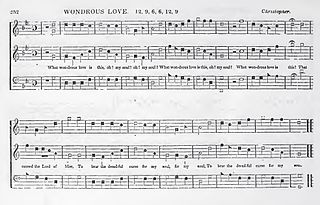
"What Wondrous Love Is This" is a Christian folk hymn from the American South. Its text was first published in 1811, during the Second Great Awakening, and its melody derived from a popular English ballad. Today it is a widely known hymn included in hymnals of many Christian denominations.

"Praise, my soul, the King of heaven" is a Christian hymn. Its text, which draws from Psalm 103, was written by Anglican divine Henry Francis Lyte. First published in 1834, it endures in modern hymnals to a setting written by John Goss in 1868, and remains one of the most popular hymns in English-speaking denominations.

"And Can It Be That I Should Gain?" is a Christian hymn written by Charles Wesley in 1738 to celebrate his conversion, which he regarded as having taken place on 21 May of that year. The hymn celebrates personal salvation through the death and resurrection of Jesus, and is one of the most popular Methodist hymns today.
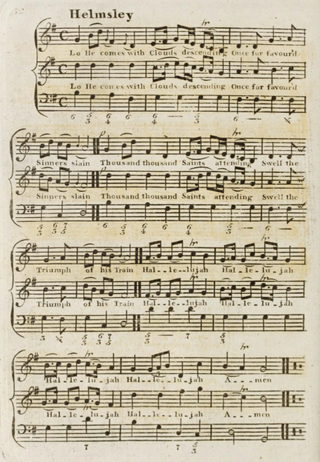
"Lo! He comes with clouds descending" is a Christian hymn by Charles Wesley (1707–1788), based on an earlier hymn, "Lo! He cometh, countless Trumpets" by John Cennick (1718–1755). Most commonly sung at Advent, the hymn derives its theological content from the Book of Revelation relating imagery of the Day of Judgment. Considered one of the "Great Four Anglican Hymns" in the 19th century, it is most commonly sung to the tune Helmsley, first published in 1763.
"At the Name of Jesus" is an 1870 hymn with lyrics written by Caroline Maria Noel. The hymn appears in at least 206 hymnals.
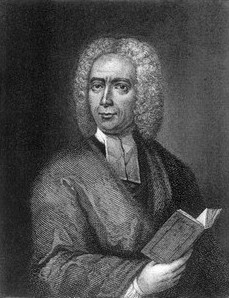
"Alas! and Did My Saviour Bleed" is a hymn by Isaac Watts, first published in 1707. The words describe the crucifixion of Jesus and reflect on an appropriate personal response to this event. The hymn is commonly sung with a refrain added in 1885 by Ralph E. Hudson; when this refrain is used, the hymn is sometimes known as "At the Cross". The final line of the first stanza has attracted some criticism, as it leads the singer to call themselves a "worm". Hymnals often change the line from "for such a worm as I" to "for such a one as I" or "for sinners such as I".














